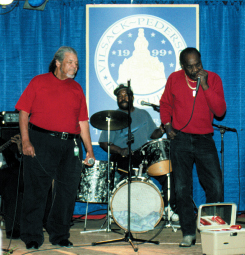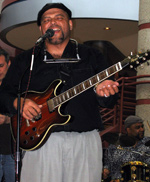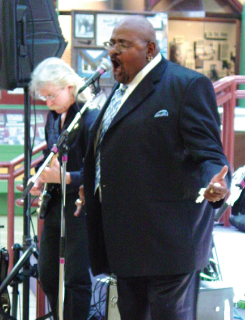| |
|
|
||
| |
|
|
||
| |
| Blues |
The Music Within that structure, however, is room for individual creativity.
Three-chord progressions in a minor key most typify the blues "riff" or structure of a blues tune. Lead lines on guitar or harmonica are popular breaks between verses, and some players have perfected "bottleneck" strains (noting strings with a glass tube, or bottle-neck over one finger), or "bending" notes by stretching a string during its resonance. The main idea is to echo the emotional qualities of the voice through
improvisational technique. TOP The Lyrics
Blues in Iowa Influences In the 21st Century, most of the Iowa musicians playing blues are white as are the sidemen (band members) of the lead musicians noted above. During the folksong revival in the 1950s and 1960s, many young people became interested in what is now called "roots" music. Both Elvis Presley and Bob Dylan found their musical influences among African American traditional musicians, as did the Grateful Dead.
The sounds of Chicago and St. Louis are most apparent in blues music in Iowa, though the indirect rhythmic influences of Kansas City and New Orleans are still clearly felt. The big easy voices of Ernie Peniston and Kevin Burt, Ethelene Wright's edgy vocals, and the soulful guitar playing of James Kinds and Charlie James Morgan surprise many who do not think of Iowa as having a particularly diverse culture. But the caliber of such musicians makes it clear that they are part of a larger African American contribution to one of our country's most popular forms of music. TOP
Text by Riki Saltzman. Photos by Riki Saltzman, Will Thomson, Dorothy Dvorachek, & Scott Allen. Photo of Joanne Jackson is reproduced with permission of Scott Allen/Vividpix & Design. Music by Ernie Peniston and Kevin "B.F." Burt.
|
 Blues has its roots in the "call and response" singing style common to Western Africa, African American gospel music, and traditional work songs. The lead singer sings a line, which is then answered or repeated; in blues, the lead instrument also answers the vocalist. One common blues pattern is AAB; the first line of a verse is repeated and the third line rhymes with the first and second. The lead is passed around among the vocalist, lead guitar, harmonica, or keyboard, but the basic structure remains the same.
Blues has its roots in the "call and response" singing style common to Western Africa, African American gospel music, and traditional work songs. The lead singer sings a line, which is then answered or repeated; in blues, the lead instrument also answers the vocalist. One common blues pattern is AAB; the first line of a verse is repeated and the third line rhymes with the first and second. The lead is passed around among the vocalist, lead guitar, harmonica, or keyboard, but the basic structure remains the same. 

 Iowa and blues musicians have drawn their inspiration from many sources.
Iowa and blues musicians have drawn their inspiration from many sources. 